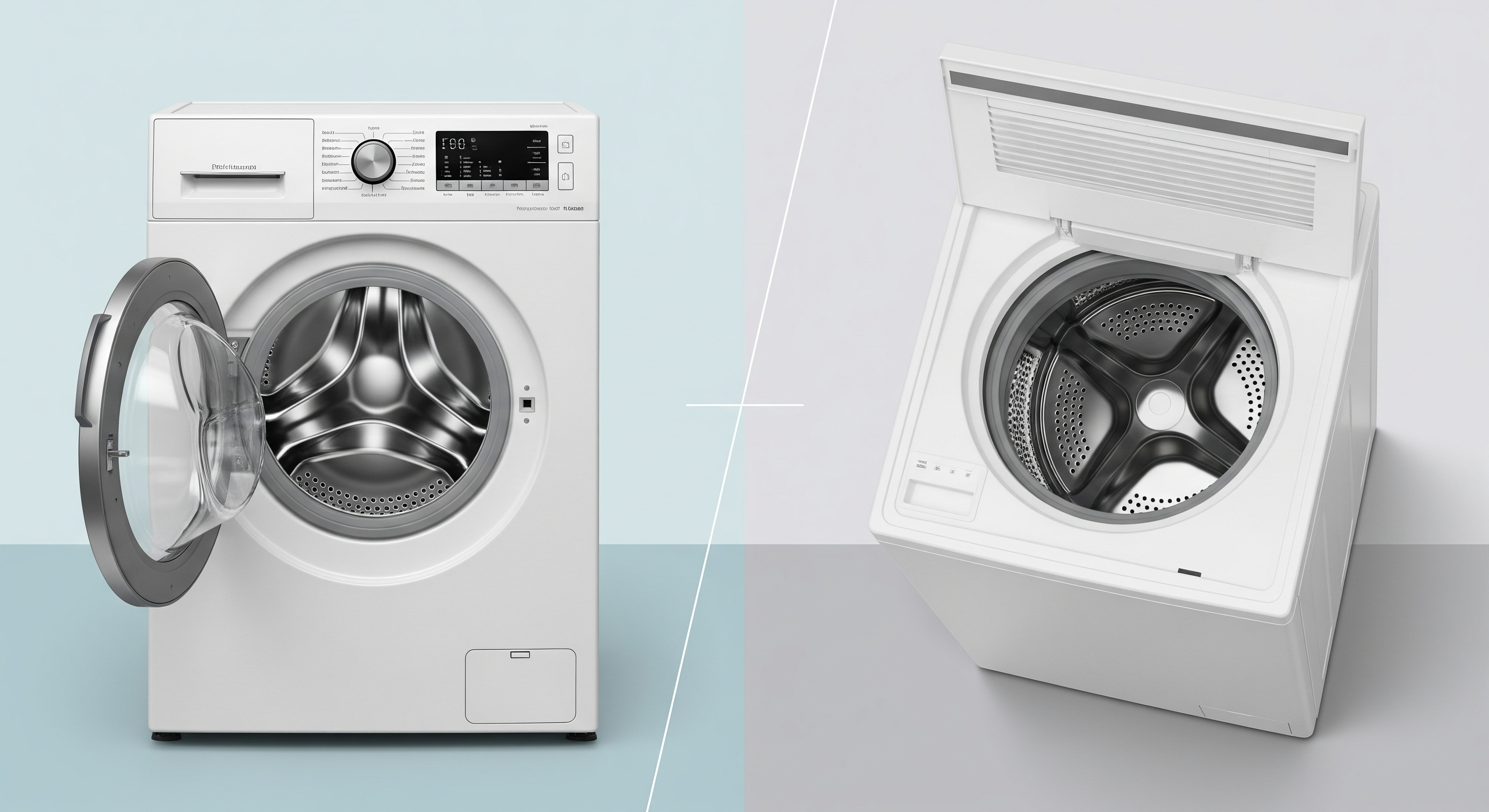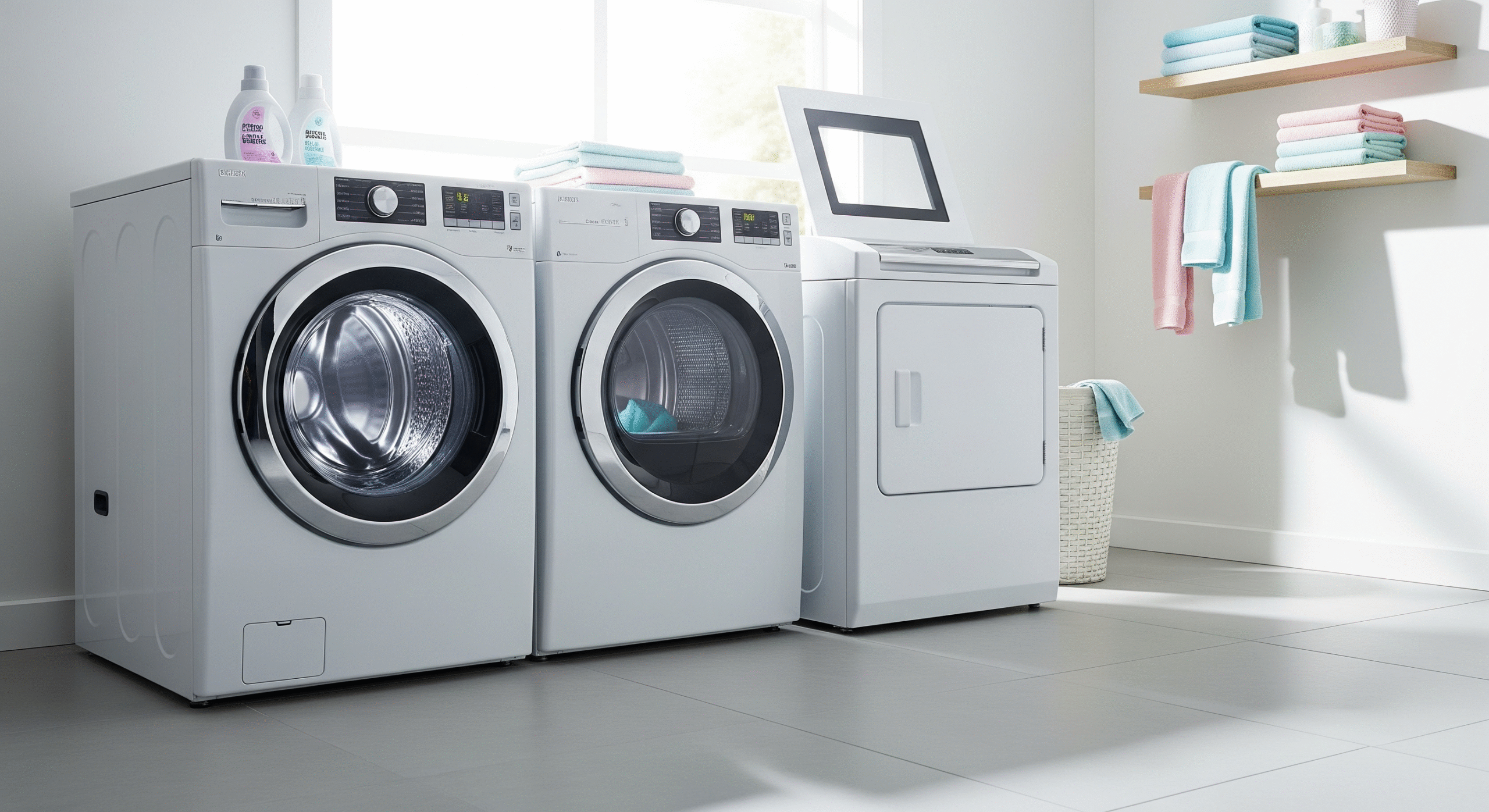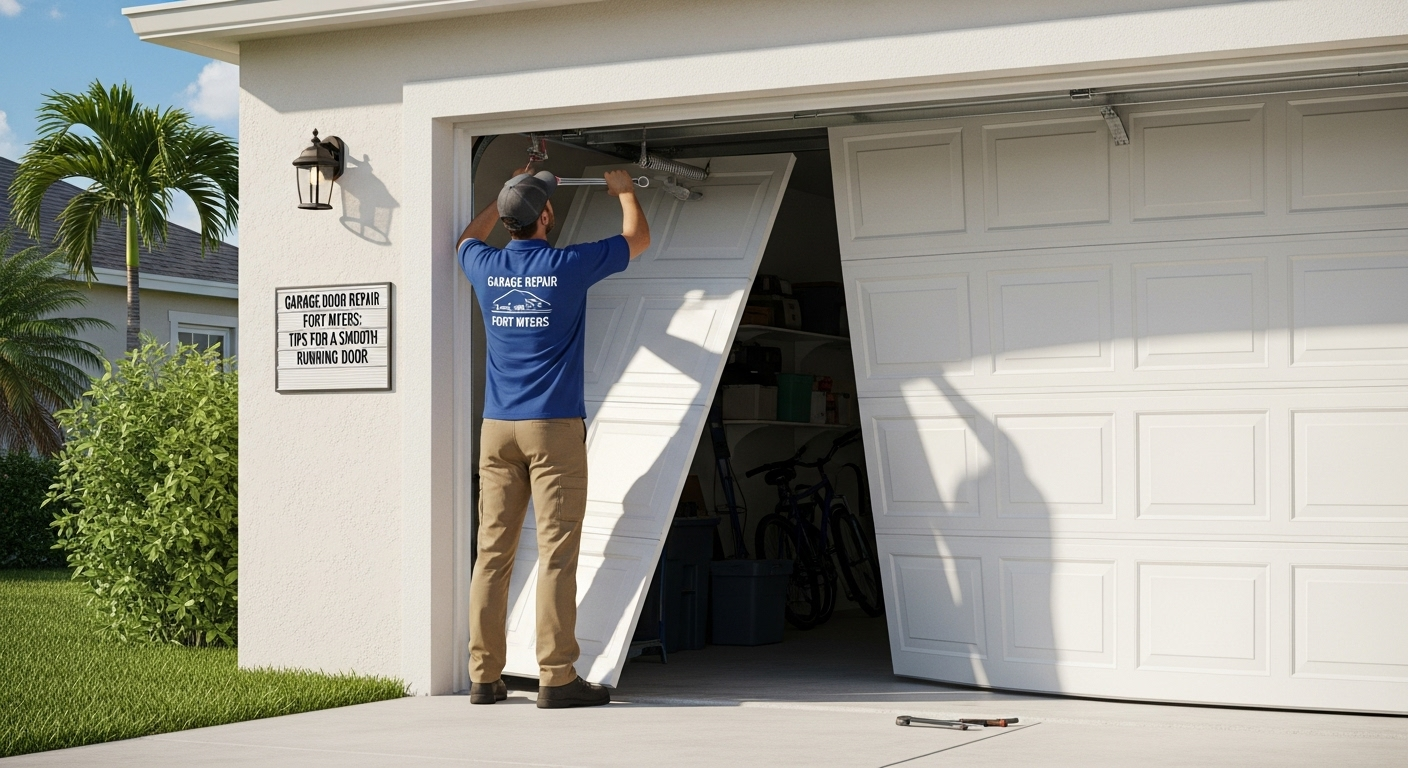Choosing between a front door vs top door washing machine can feel overwhelming, especially with the variety of features, designs, and performance factors to consider. Both types offer unique benefits, but the right choice depends on your household needs, budget, and laundry preferences. In this comprehensive guide, we’ll explore the key differences between front-load and top-load washing machines, helping you make an informed decision. Whether you prioritize energy efficiency, cleaning performance, or convenience, this article will break down everything you need to know to find the perfect washing machine for your home.
Table of Contents
What Are Front Door vs Top Door Washing Machines?
Before diving into the differences, let’s clarify what sets these two types of washing machines apart.
Front Door Washing Machines
Front-load washing machines feature a horizontal drum and a door on the front. Clothes tumble through a small pool of water, relying on gravity for effective cleaning. These machines are known for their efficiency and are commonly found in high-end and commercial laundry settings.
Top Door Washing Machines
Top-load washing machines have a vertical drum with a lid on top. Clothes are submerged in water, and an agitator or impeller moves them to clean. This design is popular in regions like the United States and Canada due to its ease of use and affordability.
Key Differences Between Front Door vs Top Door Washing Machines
To help you decide which machine suits your needs, here are the 10 main differences between front door and top door washing machines, with insights into their pros and cons.


1. Design and Loading
- Front Door: Features a side-opening door, requiring you to bend down to load and unload laundry. The horizontal drum allows for gentler tumbling motions.
- Top Door: Has a top-opening lid, making it easier to load without bending. You can also add items mid-cycle in most models.
2. Energy Efficiency
- Front Door: Highly energy-efficient, using one-third less water than top-loaders due to their tumbling action. Many models, like those from Electrolux, feature EcoInverter motors for reduced energy consumption.
- Top Door: Consumes less electricity due to shorter wash cycles but uses more water, as clothes are fully submerged.
3. Cleaning Performance
- Front Door: Excels at stain removal thanks to the tumbling motion, which provides consistent fabric-on-fabric scrubbing. Ideal for delicate fabrics and tough stains like oil or wine.
- Top Door: Less effective for larger items like coats or pillows, as clothes can clump during the twisting wash motion. However, some high-efficiency models have improved cleaning algorithms.
4. Capacity
- Front Door: Offers larger capacity due to the absence of an agitator, allowing you to wash bulkier loads and reduce the number of cycles.
- Top Door: Typically has a smaller capacity because of the central agitator or impeller, requiring more frequent loads for larger households.
5. Cycle Time
- Front Door: Longer wash cycles (often 60–90 minutes) due to complex cleaning processes and multiple water fill-and-drain stages.
- Top Door: Shorter cycles (30–60 minutes) since the tub is filled only once, making it ideal for those needing quick laundry turnaround.
6. Spin Speed
- Front Door: Higher spin speeds (up to 1500 RPM) extract more water, reducing drying time and energy use in the dryer.
- Top Door: Lower spin speeds (around 600 RPM) leave clothes wetter, increasing drying time.
7. Noise and Vibration
- Front Door: Quieter operation with less vibration, thanks to advanced suspension systems and horizontal drum design.
- Top Door: Tends to be noisier and vibrates more, especially during spin cycles, which can be disruptive in small spaces.
8. Space Utilization
- Front Door: Stackable with dryers, making them ideal for compact spaces like apartments or closets. A stacking kit or laundry pedestal can optimize space and ergonomics.
- Top Door: Narrower footprint but cannot be stacked, limiting vertical space use for storage or other appliances.
9. Convenience
- Front Door: Less convenient for adding items mid-cycle, and the lower door height may pose challenges for those with mobility issues. However, some models allow mid-cycle additions.
- Top Door: Easier to load and unload without bending, and most models allow adding items during the wash. Safer for homes with children, as the door is higher.
10. Price and Cost of Ownership
- Front Door: Higher upfront cost but saves money long-term due to water and energy efficiency. Mid-range models ($800–$1,400) are built to last 8–10 years, per Wirecutter.
- Top Door: More affordable initially, but cheaper models may use lower-quality materials, leading to a shorter lifespan (5–7 years) and higher long-term costs.
Advantages of Front Door Washing Machines
Front door washing machines often stand out for their advanced features and efficiency. Here are the key reasons why they might be the better choice for your home.
Superior Cleaning and Fabric Care
The tumbling motion of front-loaders is gentler on clothes, reducing wear and tear on delicate fabrics like silk or wool. Technologies like SensorWash (found in Electrolux models) use AI to adjust cycle times based on soil levels, effectively removing stains without pre-treatment.
Energy and Water Savings
Front-loaders use less water and energy, making them eco-friendly and cost-effective over time. Their high spin speeds also reduce dryer energy consumption, saving you money on utility bills.
Space Optimization
Stackable designs make front-loaders perfect for small homes or apartments. Pairing a front-load washer with a matching dryer creates a seamless, space-saving laundry setup.
Advanced Features
Front-loaders often come with cutting-edge features like:
- HygienicCare: Removes up to 99.9% of allergens and germs using steam.
- UltraMix: Prevents detergent residue by thoroughly mixing detergent with water.
- AutoDose: Ensures precise detergent use, minimizing waste and fabric damage.
Advantages of Top Door Washing Machines
Top door washing machines remain popular for their affordability and ease of use. Here’s why they might be the right fit for you.
Budget-Friendly Option
Top-loaders are generally cheaper upfront, making them ideal for budget-conscious buyers or those replacing an older machine without breaking the bank.
Ergonomic Design
The top-loading design eliminates the need to bend, which is a significant advantage for older adults or those with mobility challenges. It’s also easier to spot small items like socks in the tub.
Flexibility for Heavy Soils
Top-loaders with “deep fill” options excel at cleaning heavily soiled items like work clothes or sports gear, as more water helps suspend dirt and prevent redepositing.
Comparison Table: Front Door vs Top Door Washing Machines
| Feature | Front Door Washers | Top Door Washers |
|---|---|---|
| Design | Side-opening door, horizontal drum | Top-opening lid, vertical drum |
| Energy Efficiency | Uses less water, slightly more electricity | Uses more water, less electricity |
| Cleaning Performance | Better stain removal, gentler on fabrics | Less effective for large items, rougher on clothes |
| Capacity | Larger, no agitator | Smaller due to agitator/impeller |
| Cycle Time | Longer (60–90 min) | Shorter (30–60 min) |
| Spin Speed | Up to 1500 RPM | Around 600 RPM |
| Noise | Quieter, less vibration | Noisier, more vibration |
| Space | Stackable, ideal for small spaces | Narrower but not stackable |
| Convenience | Less flexible for mid-cycle additions | Easy to add items mid-cycle |
| Price | Higher upfront cost, better long-term savings | Lower upfront cost, shorter lifespan |
Which Is Best for You?
Choosing between a front door vs top door washing machine depends on your priorities:
- Choose a Front Door Washer If:
- You prioritize energy efficiency and long-term savings.
- You need a stackable machine for a small space.
- You want superior cleaning for delicate fabrics or tough stains.
- You’re willing to invest in advanced features like steam cleaning or AI sensors.
- Choose a Top Door Washer If:
- You’re on a tight budget or prefer a lower upfront cost.
- You value convenience and ergonomic loading.
- You frequently wash heavily soiled items like muddy clothes.
- You need shorter wash cycles for quick laundry tasks.
Tips for Choosing the Right Washing Machine
- Assess Your Space: Measure your laundry area to determine if a stackable front-loader or a narrower top-loader fits best.
- Consider Your Laundry Habits: Frequent washers or those with large families may benefit from a front-loader’s larger capacity and efficiency.
- Check Energy Ratings: Look for energy-efficient models with certifications to reduce utility costs.
- Read Reviews: Research user feedback on reliability and performance for specific models.
- Test Ergonomics: If mobility is a concern, visit a store to test loading and unloading both types.
Conclusion
The front door vs top door washing machine debate boils down to your lifestyle, budget, and laundry needs. Front-loaders shine with their energy efficiency, superior cleaning, and space-saving designs, making them ideal for eco-conscious households or those with limited space. Top-loaders offer affordability, convenience, and flexibility for heavy-duty cleaning, perfect for budget shoppers or those needing quick cycles. By weighing the differences outlined in this guide, you can confidently choose a washing machine that enhances your laundry experience while meeting your practical needs.
FAQs: Front Door vs Top Door Washing Machine
What is the main difference between a front door vs top door washing machine?
The main difference lies in the design: front door washing machines have a side-opening door with a horizontal drum, while top door machines have a top-opening lid with a vertical drum, affecting loading convenience and cleaning efficiency.
Which is more energy-efficient: front door vs top door washing machine?
Front door washing machines are more energy-efficient, using up to one-third less water than top door models, though top-loaders may consume less electricity due to shorter cycles.
Can I add clothes mid-cycle in a front door vs top door washing machine?
Top door washing machines generally allow adding clothes mid-cycle more easily. Some front door models offer this feature, but it’s less common and may depend on the brand.
Are front door washing machines better for small spaces?
Yes, front door washing machines are ideal for small spaces because they can be stacked with a dryer, saving floor space, unlike top door models, which cannot be stacked.
Which washing machine type is better for stain removal?
Front door washing machines excel at stain removal due to their tumbling motion, which provides better scrubbing action compared to the twisting motion of top door machines.

